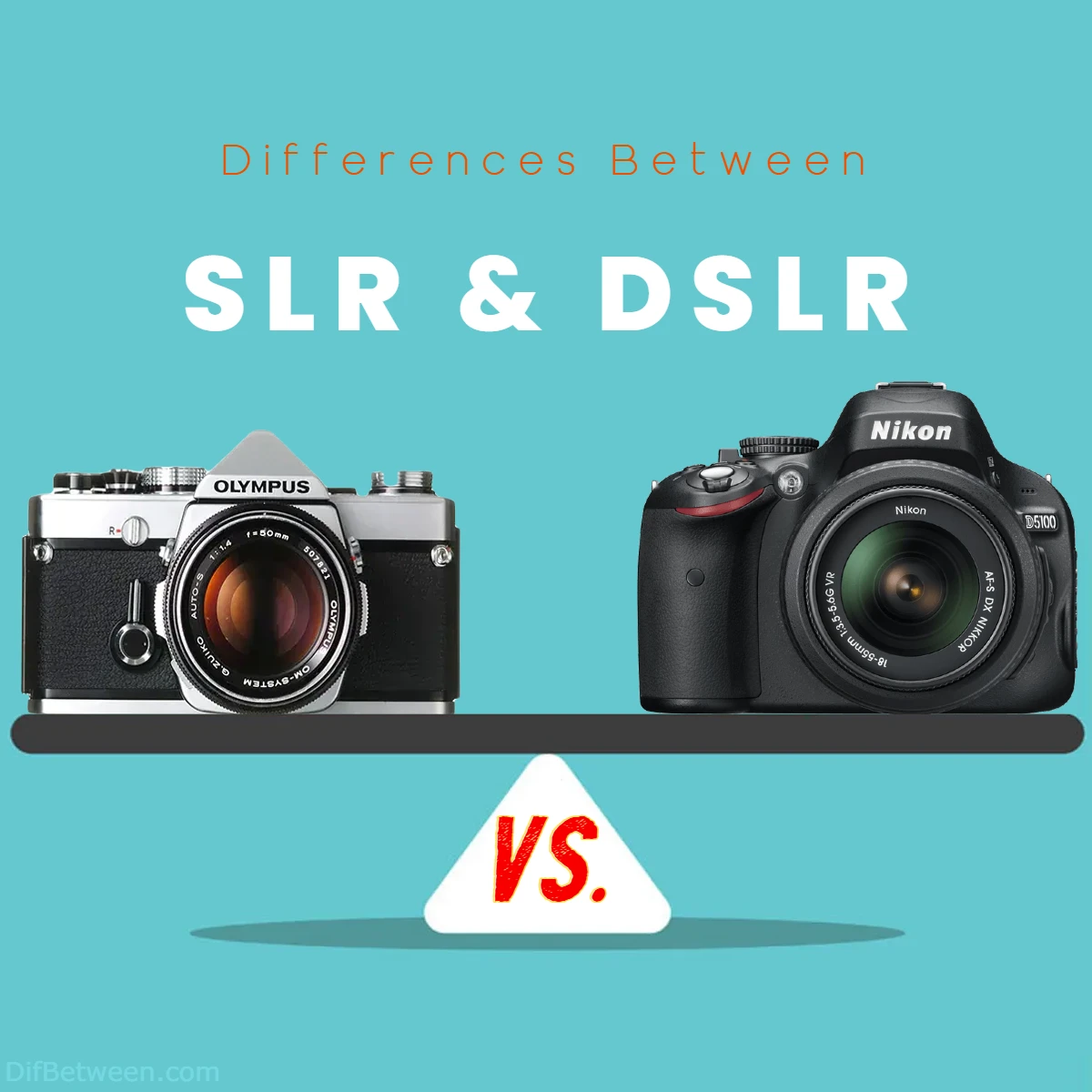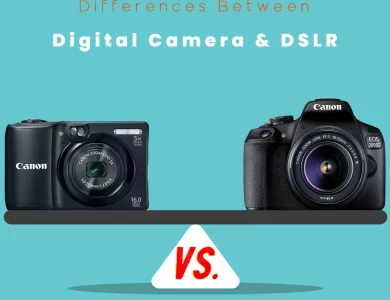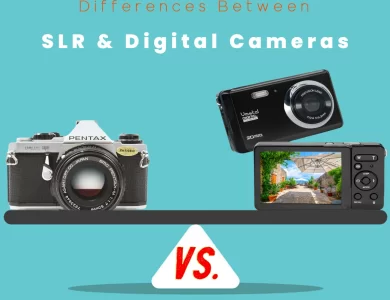
The main differences between SLR (Single Lens Reflex) and DSLR (Digital Single Lens Reflex) cameras lie in their technology and functionality. While both utilize a mirror and prism system for optical viewing, the key distinction arises in the image capture medium. SLR cameras employ traditional film, necessitating manual development, whereas DSLR cameras utilize digital sensors, enabling instant image processing. Additionally, DSLRs often feature advanced autofocus systems, live view LCD screens, and high-definition video recording capabilities, setting them apart from their analog counterparts. The transition to digital technology enhances the overall efficiency and convenience of DSLRs, making them a preferred choice for modern photographers seeking versatility and cutting-edge features.
| Feature | SLR Camera | DSLR Camera |
|---|---|---|
| Image Capture Medium | Film | Digital Sensors (CCD or CMOS) |
| Processing Speed | Manual film development | Instant digital image processing |
| Low-Light Performance | Dependent on film sensitivity | Improved performance with CMOS sensors |
| Autofocus Technology | Phase Detection | Phase Detection, Contrast Detection (Hybrid systems) |
| Low-Light Autofocus Performance | Limited performance in low light | Enhanced autofocus performance in low-light settings |
| Viewfinder Type | Optical Viewfinder | Optical Viewfinder, Electronic Viewfinder (optional) |
| Parallax Error | Present due to optical design | Reduced parallax error with improved optical elements |
| Live View Functionality | Absent | Present with LCD screen for composing shots |
| Video Recording Capability | Limited or absent | High-definition video recording with various options |
| Weight and Size | Bulkier and heavier | Compact and lightweight, varying by model |
| Portability | Potentially less portable | Generally more portable, suitable for travel |
| Initial Cost | Potentially lower initial cost | Higher initial cost, but cost-effective in the long run |
| Ongoing Expenses | Film, development, and printing | Minimal ongoing expenses with digital photography |
Key Differences Between SLR and DSLR Cameras
When it comes to capturing life’s moments in vivid detail, the choice between Single Lens Reflex (SLR) and Digital Single Lens Reflex (DSLR) cameras is a pivotal decision for photographers. Both offer advanced features and exceptional image quality, but understanding their nuances is crucial. In this comprehensive guide, we will explore the key differences between SLR and DSLR cameras, shedding light on the various aspects that set them apart.
Basic Design and Mechanism
The core difference between SLR and DSLR cameras lies in their basic design and operational mechanism. Single Lens Reflex cameras, commonly known as SLRs, employ a mirror and prism system. When the shutter button is pressed, the mirror flips up, allowing light to hit the film or image sensor directly.
On the other hand, Digital Single Lens Reflex (DSLR) cameras take advantage of modern technology by replacing film with digital sensors. These sensors capture light and convert it into digital signals, resulting in high-resolution images. Unlike SLRs, DSLRs use a pentaprism or pentamirror to direct light to the optical viewfinder, giving photographers a real-time preview of the scene.
Image Sensor Technology
The transition from film to digital sensors marks a significant leap in photography. SLR cameras predominantly use film, requiring manual development and processing. In contrast, DSLR cameras are equipped with digital image sensors, either CCD (Charge-Coupled Device) or CMOS (Complementary Metal-Oxide-Semiconductor). These sensors convert light into electrical signals, facilitating the creation of digital images.
CCD sensors, commonly found in older DSLR models, provide high-quality images with low noise levels but consume more power. On the other hand, CMOS sensors, prevalent in modern DSLRs, offer better energy efficiency, faster processing, and improved performance in low-light conditions. The choice between CCD and CMOS is a crucial factor influencing the image quality and overall functionality of a camera.
| Feature | SLR Camera | DSLR Camera |
|---|---|---|
| Image Capture Medium | Film | Digital Sensors (CCD or CMOS) |
| Processing Speed | Manual film development | Instant digital image processing |
| Low-Light Performance | Dependent on film sensitivity | Improved performance with CMOS sensors |
Autofocus Systems
Autofocus capabilities play a pivotal role in capturing sharp and well-focused images. SLR cameras traditionally use phase-detection autofocus, a technology that measures the convergence of two beams of light. While effective, this system may struggle in low-light conditions and may require additional auxiliary lighting for optimal performance.
In contrast, DSLR cameras leverage more advanced autofocus systems, often incorporating contrast-detection and phase-detection technologies. This enables faster and more accurate focusing, even in challenging lighting situations. Moreover, many DSLRs offer multiple autofocus points, allowing photographers to fine-tune their focus on specific areas of the frame.
| Feature | SLR Camera | DSLR Camera |
|---|---|---|
| Autofocus Technology | Phase Detection | Phase Detection, Contrast Detection (Hybrid systems) |
| Low-Light Autofocus Performance | Limited performance in low light | Enhanced autofocus performance in low-light settings |
Viewfinder Experience
The viewfinder is a crucial component for framing and composing shots. SLR cameras utilize an optical viewfinder, offering a direct optical view through the lens via a series of mirrors and prisms. While this provides an accurate representation of the scene, the viewfinder image may not precisely match the final captured image due to parallax error.
DSLR cameras maintain the optical viewfinder experience but with enhancements. The use of pentaprisms or pentamirrors ensures a brighter and clearer view, making it easier for photographers to compose their shots. Additionally, some DSLRs feature electronic viewfinders (EVFs), providing a digital representation of the scene with real-time exposure and depth-of-field information.
| Feature | SLR Camera | DSLR Camera |
|---|---|---|
| Viewfinder Type | Optical Viewfinder | Optical Viewfinder, Electronic Viewfinder (optional) |
| Parallax Error | Present due to optical design | Reduced parallax error with improved optical elements |
Live View and Video Recording
The advent of digital technology has ushered in new possibilities, including live view functionality and video recording. SLR cameras, rooted in film photography, lack live view capabilities, requiring photographers to compose shots using the optical viewfinder. Additionally, video recording is typically absent or limited in SLRs.
In contrast, DSLR cameras embrace modern trends, featuring live view LCD screens that allow photographers to compose shots using the digital display. This is particularly advantageous for capturing images from awkward angles or using manual focus. Moreover, most DSLRs excel in video recording, offering high-definition recording capabilities and various frame rate options.
| Feature | SLR Camera | DSLR Camera |
|---|---|---|
| Live View Functionality | Absent | Present with LCD screen for composing shots |
| Video Recording Capability | Limited or absent | High-definition video recording with various options |
Weight and Size
The physical characteristics of cameras impact their portability and ease of use, especially for photographers on the move. SLR cameras tend to be bulkier and heavier due to their mechanical components, including the mirror and prism system. While this can be seen as a drawback in terms of portability, some photographers appreciate the robust feel and stability offered by larger camera bodies.
DSLR cameras, benefiting from advancements in materials and technology, are generally more compact and lightweight. The absence of complex mechanical systems contributes to their reduced weight, making them more suitable for travel and outdoor photography. However, it’s essential to strike a balance between size and ergonomics based on individual preferences.
| Feature | SLR Camera | DSLR Camera |
|---|---|---|
| Weight and Size | Bulkier and heavier | Compact and lightweight, varying by model |
| Portability | Potentially less portable | Generally more portable, suitable for travel |
Cost Considerations
The financial aspect is a significant factor for photographers at all levels. SLR cameras, especially film models, may have a lower initial cost, making them an attractive option for beginners or those on a tight budget. However, it’s crucial to factor in ongoing expenses for film, development, and printing.
DSLR cameras, while often pricier upfront, offer cost savings in the long run. Digital photography eliminates the need for film, and images can be reviewed and deleted without any additional cost. Moreover, the ability to share digital images instantly reduces expenses associated with printing.
| Feature | SLR Camera | DSLR Camera |
|---|---|---|
| Initial Cost | Potentially lower initial cost | Higher initial cost, but cost-effective in the long run |
| Ongoing Expenses | Film, development, and printing | Minimal ongoing expenses with digital photography |
Which One is Right Choose? SLR or DSLR
Assessing Your Photography Needs
The first step in determining the right choice between SLR and DSLR is to assess your specific photography needs. Consider the type of photography you’re passionate about, whether it’s portrait, landscape, macro, or action photography. Each camera type has its strengths, so understanding your preferences will guide you in making an informed decision.
If you appreciate the classic, hands-on experience of film photography and don’t mind the manual development process, an SLR might be a fitting choice. On the other hand, if you crave the convenience of digital technology, quick access to settings, and the ability to shoot in various conditions, a DSLR is likely more suitable.
Budgetary Considerations
Your budget plays a pivotal role in the decision-making process. While SLR cameras may have a lower initial cost, it’s crucial to factor in ongoing expenses associated with film, development, and printing. If you’re on a tight budget and willing to embrace the analog charm of film photography, an SLR could be a cost-effective choice.
Conversely, if you have the flexibility to invest more upfront and prefer the financial benefits of digital photography, a DSLR might be a better fit. Consider the long-term savings on film and the convenience of instant image review, sharing, and storage.
Weight and Portability Preferences
The physical characteristics of the camera can significantly impact your shooting experience, especially if you plan to take your camera on the go. SLR cameras are often bulkier and heavier due to their mechanical components. If you value the solid feel and stability of a larger camera body, the size may not be a concern.
However, if portability is a priority, a DSLR’s compact and lightweight design could be more appealing. Consider your shooting style and whether you prefer a camera that’s easy to carry for extended periods, making it suitable for travel, hiking, or other on-the-go scenarios.
Technological Advancements and Features
Embracing technological advancements is a key consideration. DSLR cameras incorporate the latest features, including advanced autofocus systems, live view functionality, and high-definition video recording. If you’re keen on staying at the forefront of technology and having a versatile tool at your disposal, a DSLR is likely the better choice.
However, if you appreciate the simplicity and authenticity of traditional photography without the need for advanced features, an SLR may align better with your artistic vision. Consider whether you’re drawn to the creative possibilities offered by digital advancements or if you prefer the timeless appeal of analog photography.
Personal Shooting Style and Preferences
Your personal shooting style and preferences should be at the forefront of your decision-making process. If you enjoy the tactile experience of manually adjusting settings and the anticipation of film development, an SLR provides a hands-on and immersive photographic journey. The deliberate nature of shooting with film may enhance your connection to the art of photography.
On the other hand, if you value the convenience of digital technology, quick access to settings, and the ability to experiment with various shooting modes, a DSLR caters to a more dynamic and flexible shooting style. Consider whether you find joy in the process of crafting an image with precision or if you thrive in the spontaneity and immediacy of digital photography.
Conclusion: Finding Your Perfect Match
In the end, the choice between SLR and DSLR is a highly personal one, influenced by your artistic vision, budget, and shooting preferences. Take the time to reflect on what aspects of photography resonate with you the most. Whether you choose the nostalgic charm of an SLR or the cutting-edge features of a DSLR, both options have their unique merits.
Your camera is not just a tool; it’s an extension of your creative expression. Consider the journey you want to embark on, from capturing the light on film to harnessing the power of digital technology. Whichever path you choose, embrace the joy of photography and let your camera be the companion that helps you turn moments into timeless memories.
FAQs
The primary distinction lies in the image capture medium. SLR cameras use traditional film, requiring manual development, while DSLRs leverage digital sensors for instant image processing.
SLR cameras typically use phase-detection autofocus, while DSLRs often feature advanced systems, including phase-detection and contrast-detection technologies, ensuring faster and more accurate focusing.
SLRs use an optical viewfinder, providing a direct optical view through the lens. DSLRs enhance this experience with brighter and clearer viewfinders, some even offering electronic viewfinders for additional digital information.
Yes, DSLRs excel in modern features like live view LCD screens, enabling digital composition, and high-definition video recording capabilities, which are often limited or absent in traditional SLR cameras.
SLR cameras are bulkier and heavier due to their mechanical components, while DSLRs, with advancements in technology, are generally more compact and lightweight, making them more portable.
While SLRs may have a lower initial cost, DSLRs offer long-term savings as they eliminate expenses related to film, development, and printing, making them cost-effective over time.
Yes, DSLRs incorporate the latest features like advanced autofocus, live view functionality, and high-definition video recording, embracing digital technology for a more versatile and dynamic photographic experience.
Read More:
Contents






